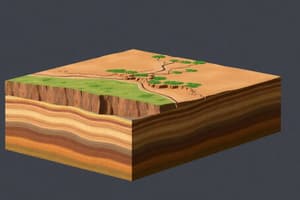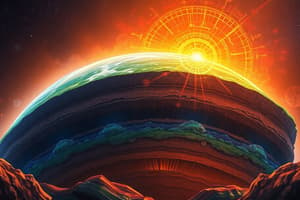Podcast
Questions and Answers
The three distinct chemical layers of the Earth are the crust, mantle, and ______.
The three distinct chemical layers of the Earth are the crust, mantle, and ______.
core
Continental crust has a relatively low density and composition similar to ______.
Continental crust has a relatively low density and composition similar to ______.
granite
Oceanic crust has a relatively high density, especially when cold and old, and composition similar to ______.
Oceanic crust has a relatively high density, especially when cold and old, and composition similar to ______.
basalt
The boundary between the crust and the mantle is known as the ______.
The boundary between the crust and the mantle is known as the ______.
Earthquakes generally occur in the upper crust and are caused by the rapid movement of relatively ______ materials.
Earthquakes generally occur in the upper crust and are caused by the rapid movement of relatively ______ materials.
The Moho is found roughly 5 km below the ocean floor and about 30-40 km below the surface under the ______.
The Moho is found roughly 5 km below the ocean floor and about 30-40 km below the surface under the ______.
The mantle is the largest chemical layer by volume, extending from the base of the crust to a depth of about ______ km.
The mantle is the largest chemical layer by volume, extending from the base of the crust to a depth of about ______ km.
Scientists studied ______, which are carried within magma and brought to the Earth’s surface by volcanic eruptions.
Scientists studied ______, which are carried within magma and brought to the Earth’s surface by volcanic eruptions.
The core consists mostly of iron and ______, and possibly some oxygen.
The core consists mostly of iron and ______, and possibly some oxygen.
Perovskite silicates are thought to be the main component of the lower ______, making it the most common mineral in that region.
Perovskite silicates are thought to be the main component of the lower ______, making it the most common mineral in that region.
Flashcards are hidden until you start studying
Study Notes
Earth's Chemical Layers
- The Earth is composed of three distinct chemical layers: crust, mantle, and core.
- The crust is the outermost layer, composed of two types: continental crust (granitic, low density) and oceanic crust (basaltic, high density).
- The crust is brittle near the surface but becomes more ductile at depth due to increased pressure and temperature.
- The Mohorovičić Discontinuity (Moho) marks the transition between the crust and mantle, characterized by a significant increase in seismic velocity.
- The Moho is located approximately 5 km below the ocean floor and 30-40 km beneath continents, deepening near mountain-building zones.
- The mantle, the largest chemical layer, extends from the base of the crust to a depth of approximately 2900 km.
- It is primarily composed of peridotite, an ultramafic igneous rock.
- Information about the mantle is gathered from seismic wave analysis, ophiolites (pieces of mantle exposed on the ocean floor), and xenoliths (mantle rock transported to the surface within magma).
- The Earth's core, containing both liquid and solid layers, is primarily composed of iron and nickel, with potentially some oxygen.
- The core was first discovered in 1906 through analysis of seismic data.
- Scientists believe the core formed from metallic materials like iron and nickel that sank to the center of the Earth, liquefied by intense pressure.
Earth's Physical Layers
- The Earth can be further divided into five distinct physical layers based on how they respond to stress: lithosphere, asthenosphere, mesosphere, outer core, and inner core.
- The lithosphere is the rigid outermost layer, including the crust and uppermost part of the mantle.
- The asthenosphere is the layer beneath the lithosphere, characterized by partial melting and a ductile, "plastic-like" behavior.
- The mesosphere is the lower part of the mantle, below the asthenosphere, where the mantle is solid but still behaves in a ductile manner.
- The outer core is a liquid layer that resides beneath the mantle, primarily composed of molten iron and nickel.
- The inner core is a solid ball of iron and nickel located at the Earth's center. Even though the inner core experiences extreme temperatures, the intense pressure keeps the material in a solid state.
Studying That Suits You
Use AI to generate personalized quizzes and flashcards to suit your learning preferences.




